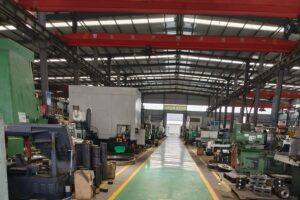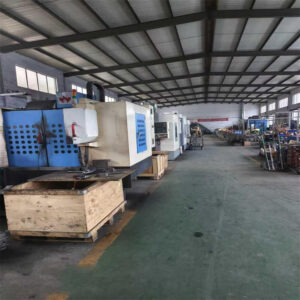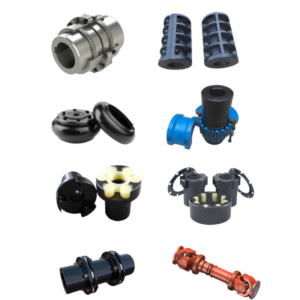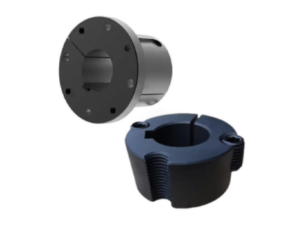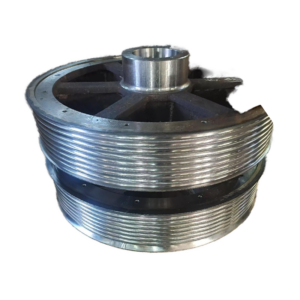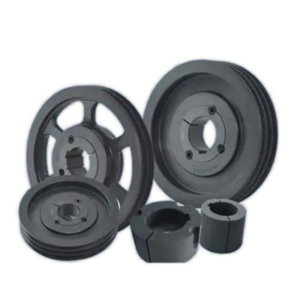Pulleys are essential components in mechanical power transmission systems, used to transfer motion and torque between rotating shafts via belts. Different types of pulleys are designed to match specific belt types and operational requirements. This article discusses the most commonly used pulleys in machinery, their advantages, and disadvantages.
1. Flat Belt Pulleys
Description:
Flat belt pulleys have a smooth, flat surface and are used with flat belts made of rubber, leather, or fabric.
Advantages:
- Simple design, low cost.
- Suitable for high-speed applications (due to reduced air resistance).
- Can accommodate slight misalignment between shafts.
- Low noise and vibration damping properties.
Disadvantages:
- Lower grip compared to V-belts, leading to potential slippage.
- Requires higher tension to maintain traction.
- Not suitable for high-torque applications.
Applications:
- Conveyor systems, textile machinery, and light-duty power transmission.
2. V-Belt Pulleys (Grooved Pulleys)
Description:
V-belt pulleys have trapezoidal grooves that match the cross-section of V-belts, providing better grip.
Advantages:
- Higher friction and power transmission capability than flat belts.
- Reduced slippage due to wedging action in the groove.
- Available in multiple standard sizes (e.g., A, B, C sections).
- Cost-effective for medium-power applications.
Disadvantages:
- Requires precise alignment to prevent belt wear.
- Belts need periodic tension adjustment.
- Efficiency decreases at very high speeds.
Applications:
- Electric motors, pumps, compressors, and industrial machinery.
3. Timing Belt Pulleys (Synchronous Pulleys)
Description:
Timing belt pulleys have teeth that mesh with the grooves of a toothed timing belt, ensuring synchronous power transmission.
Advantages:
- No slippage, precise speed ratio maintenance.
- High efficiency (~98%) and load capacity.
- No lubrication needed, low maintenance.
- Suitable for high-speed and high-precision applications.
Disadvantages:
- More expensive than V-belt or flat belt systems.
- Sensitive to misalignment, requiring precise installation.
- Belt teeth can wear or shear under excessive loads.
Applications:
- CNC machines, robotics, automotive engines (camshaft drives), and precision equipment.
4. Multi-Groove Pulleys (Serpentine Belt Pulleys)
Description:
These pulleys have multiple V-shaped grooves to accommodate multi-ribbed belts (e.g., 6-rib or 8-rib belts).
Advantages:
- Higher power transmission in compact spaces.
- Reduced belt slippage compared to single V-belts.
- Better flexibility and load distribution.
Disadvantages:
- More complex and costly than single-groove pulleys.
- Requires precise belt alignment.
Applications:
- Automotive serpentine belts, HVAC systems, and heavy-duty machinery.
5. Variable Speed Pulleys (Adjustable Pulleys)
Description:
These pulleys have adjustable sheaves to change the effective diameter, allowing variable speed control.
Advantages:
- Enables speed adjustment without additional gears.
- Smooth and continuous speed variation.
- Useful in applications requiring different operating speeds.
Disadvantages:
- Higher cost and complexity.
- Requires regular maintenance to ensure smooth adjustment.
- Lower efficiency compared to fixed-speed systems.
Applications:
- Machine tools, conveyors, and industrial equipment requiring variable speeds.
Comparison Table of Common Pulley Types
| Pulley Type | Efficiency | Load Capacity | Slippage Risk | Maintenance Needs | Best Applications |
|---|---|---|---|---|---|
| Flat Belt Pulley | Medium (~90%) | Low | High | Low | Light-duty, high-speed systems |
| V-Belt Pulley | Medium (~95%) | Medium-High | Medium | Moderate | Industrial motors, pumps |
| Timing Pulley | High (~98%) | High | None | Low | Precision machinery, robotics |
| Multi-Groove | High (~96%) | High | Low | Moderate | Automotive, heavy machinery |
| Variable Speed | Medium (~92%) | Medium | Medium | High | Adjustable-speed drives |
Conclusion
The choice of pulley depends on factors such as power requirements, speed, precision, and cost.
- For high efficiency and precision, timing belt pulleys are ideal.
- For cost-effective medium-power transmission, V-belt pulleys are widely used.
- For variable speed applications, adjustable pulleys provide flexibility.
- For compact high-power needs, multi-groove pulleys are optimal.
Proper selection and maintenance ensure optimal performance and longevity of belt-driven systems.

